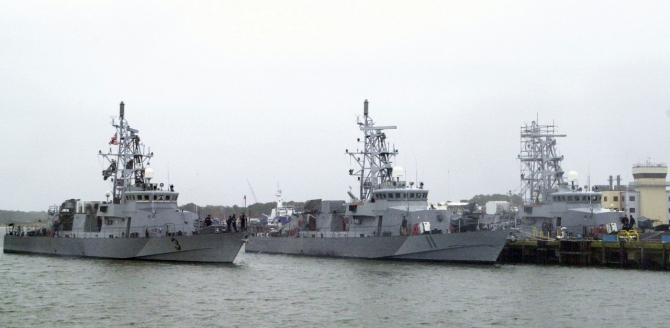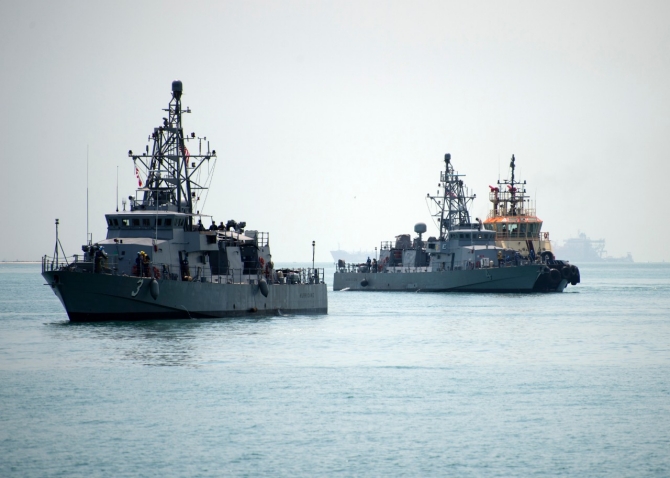Hurricane (PC-3)
1993-2023
A storm with a violent wind, in particular a tropical cyclone in the Caribbean. The first U.S. Navy ship named Hurricane.
(PC-3: displacement 334; length 178'; beam 25'; draft 8'; speed 32 knots; complement 30; armament 2 25 millimeter, 2 40 millimeter grenade launchers, 2 .50 caliber machine guns, and 2 7.62 millimeter machine guns; class Cyclone)
Hurricane (PC-3) was laid down on 20 November 1991 at Lockport, La., by Bollinger Machine Shop and Shipyard; launched on 6 June 1992; sponsored by Mrs. Elizabeth W. Cantrell; and commissioned on 15 October 1993 at Naval Air Station North Island, Calif., Lt. John P. Gelinne in command.
Following the Haitian Army’s overthrow of President Jean-Bertrand Aristide in September 1991, a succession of governments led to sectarian violence in that country, and in May 1994 the military imposed Supreme Court Justice Emile Jonassaint as provisional president. The UN authorized force to restore order, and the U.S. initiated Operations Support Democracy and Uphold/Restore Democracy: Uphold Democracy for a peaceful entry into Haiti, and Restore Democracy in the event of resistance. Hurricane patrolled the Haitian coast during Support Democracy as the Haitians agreed to allow the Americans to land peacefully, operating at times with Sea, Air, Land (SEAL) Teams. On 6 July 1994, amphibious assault ship Inchon (LPH-12) sailed from Norfolk, Va., in response to the crisis. Wasp (LHD-1) relieved Inchon in Haitian waters on 17 August. The crisis escalated the following month, however, prompting an enlarged response by a multinational force that included aircraft carriers America (CV-66) and Dwight D. Eisenhower (CVN-69). About 1,800 soldiers of the Army’s XVIII Airborne Corps embarked on board Dwight D. Eisenhower. The U.S. transferred peacekeeping functions to international forces on 31 March 1995.
Hurricane and Squall (PC-7), together with Patrol Craft crews Juliet, Lima, Kilo, and Mike, shifted their home port from Naval Amphibious Base Coronado, Calif., to Naval Amphibious Base Little Creek, Va., from 1 November–15 December 2005, a move made as part of a reorganization to better fight the global war on terrorism. The Navy intended to forward deploy five of the eight Cyclone-class ships at Naval Support Activity Bahrain, and the remaining three at Little Creek.

“SEAL [Sea, Air, Land] teams couldn’t use them because they were too large for their mission,” Lt. Bart Denny, Regional Support Organization PC transit coordinator explained, “and we started to transfer the ships to the Coast Guard. After Sept 11 [9/11], the demand for them grew. They can get to shallow waters and maneuver quickly where cruisers and destroyers can’t safely operate. This makes them a great asset for protecting oil terminals and overseas port security.” Denny further noted the logistics issue: “Keeping the ships on station in Bahrain significantly cuts down on the wear and tear of the ship and reduces the amount of time it takes to get the ship fully operational on station.”
In order to maintain the forward-deployed ships the Navy created 16 rotational crews, identified by alpha names, each crew consisting of four officers and 24 enlisted sailors. The move enabled crewmembers to learn together in a single location during seven- to 16-week training cycles.
“By moving the PCs here we’re going to standardize what we do,” Lt. Cmdr. Brian J. Diebold, Hurricane’s commanding officer, observed. “We’ll be able to train here, then fly to the 5th Fleet AOR [area of operations] and accomplish whatever mission is set before us.”
The Navy subsequently reinforced the Fifth Fleet and Hurricane and Monsoon (PC-4) shifted to Bahrain, completing their move on 13 August 2014. Their deployment raised to ten the total number of patrol craft operating within the Fifth Fleet.

Detailed history under construction.
Mark L. Evans
7 July 2015


